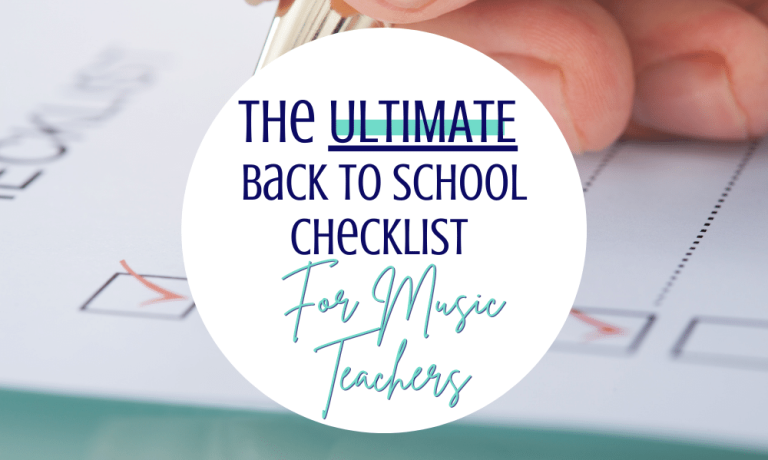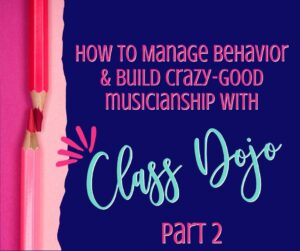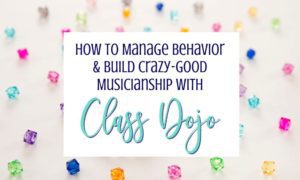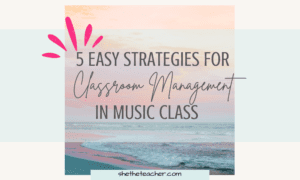The back-to-school season is a time of excitement and anticipation for both students and teachers. As music educators, we want to make sure that our classrooms are ready for the new year before our students walk in the door on the first day and this back-to-school checklist for music teachers will help!
In this blog post, I’ll walk you through 5 checklists things to do before classes start. These checklists will include everything from organizing materials to setting up classroom management procedures and more.
How to Use These Music Checklists
(aka Disclaimer)
Ok, before you get down into the checklists, know that these are meant to get you thinking about your new year– these do not need to be completed in their entirety before you walk into your classroom, but should instead just be a guide to help you plan and think through things. Use what you need and cross off what you don’t.
Want a Printable/Digital Checklist to Take with You?
If you’d prefer a digital/printable checklist PDF set (so you can cross things off, put them in your teacher binder to work on in self-directed or team work-time etc.), just enter in your email below.
The Ultimate Checklist for Music Teachers
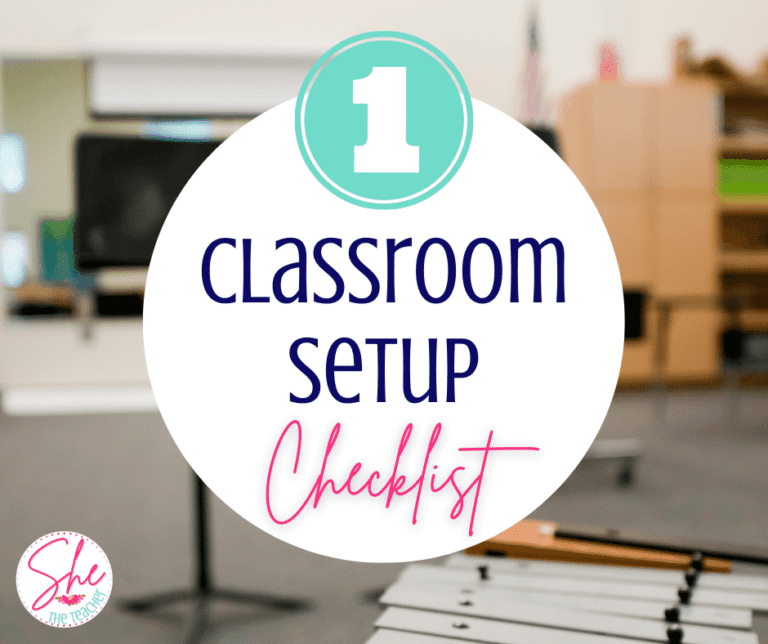
Music Classroom Setup Checklist for Music Teachers
1. Make sure you have your keys and keycard (if applicable) for your classroom
2. Set up student desks and chairs in formation
3. Hang up classroom decorations & design your room
4. Place instruments and music stands in the correct locations
5. Set up technology in the classroom
- Speakers
- Smartboard or projector
- Computer
- Microphone (if needed)
6. Place any other materials or equipment in the classroom
7. Make sure the classroom is clean and organized
8. Prepare any materials that you will need for the first day of class.

Materials and Equipment Checklist for Music Teachers
9. Make a list of the music you will need for the start of the school year
- Order music, print copies (please pay for legal copies!) or troubleshoot now how to distribute legal digital copies.
10. Gather all materials and put them in a designated area
- This could be a back room, storage closet, or cabinet
- Make sure materials are clearly labeled and easy to find
11. Check that all instruments are in working order
- This includes tuning, repairing, and cleaning instruments
- You may need to contact your school’s custodial staff or maintenance department for assistance
- Make a note of any instruments that need to be replaced
- Tune your piano (if you you have one!)
12. Count and organize all music stands
- Make sure there are enough for your class size
- You may need to order more if you don’t have enough
- Decide how students will be assigned music stands (first come, first serve; by instrument family, etc.)
13. Stock up on supplies
- Reeds, rosin, strings, valve oil, etc.
- You may want to create a sign-out system for some supplies
- Make a note of when supplies need to be replenished
14. Check that all technology is working properly
- This includes your computer, projector, and any other devices you use in class
- Make sure you have all the necessary cables and adapters
- Update your software and drivers as needed
- Create a backup of your files in case of technical difficulties
15. Make sure that you have enough music folders for your students
- You may need to order more if you don’t have enough
- Decide how students will be assigned music folders (first come, first serve; by voice part, etc.)
- Stock up on supplies such as pencils, staff paper, and highlighters
16. Don’t forget to check back-to-school sales for your software programs like:
- Finale
- SmartMusic
- Canva
- Flat.io
- Sibelius
- Sight Reading Factory etc..
Grab a free copy of 'Setting Up Your First Music Classroom' Workbook
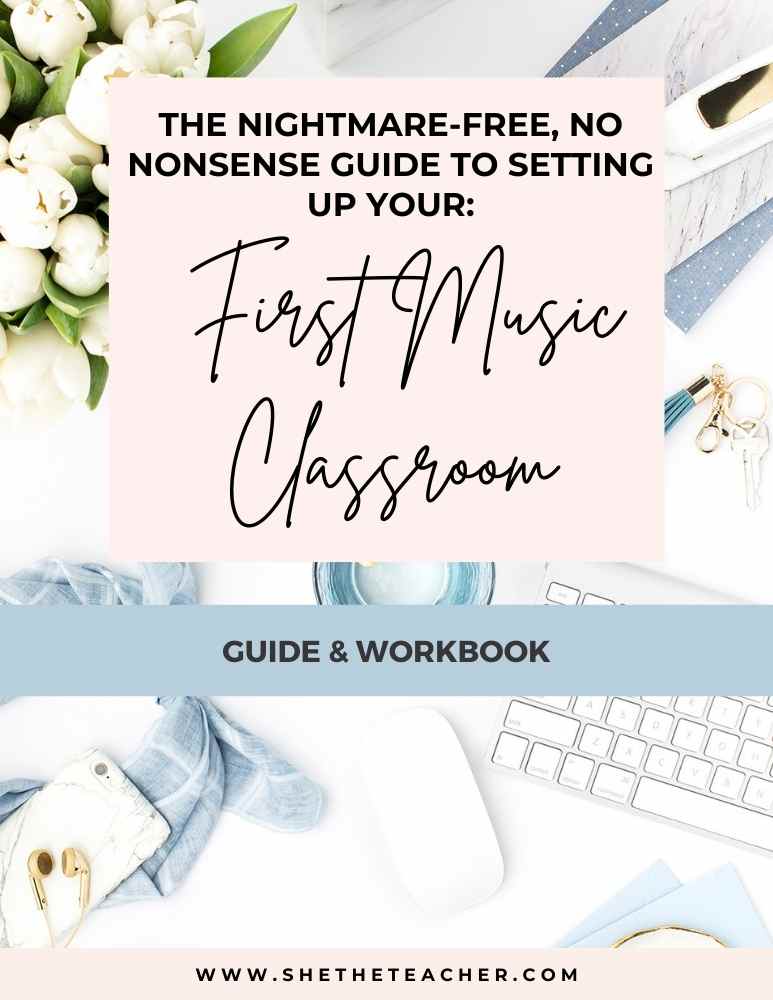
This fun workbook is jam-packed with things to consider when setting up your music classroom (even ifyou’re not a first-year music teacher).
I’ll include things like:
- Handy Planner Pages
- “The 9 People You ACTUALLY Need to Know,”
- A Mini-Setup Checklist
- My First-Day Lesson Plan and more!
Sign up below!

Classroom Management Checklist for Music Teachers
17. How will students enter your classroom?
18. What is your late work policy?
19. How will students be dismissed from class?
20. What is your policy for make-up work?
21. Are food and drinks allowed in your classroom?
22. What is your policy for using phones and other electronic devices in class?
23. How will students be grouped or seated at the beginning of the year? Will this change?
24. How will you take attendance?
25. What is your policy for bathroom breaks?
26. What will be your routine for starting class every day (what are students expected to do the moment they walk into your room)?
27. How will you handle a student who chooses not to participate?
28. When will students put away their materials and get ready for dismissal?
29. What is your policy for sharpening pencils or getting more paper?
30. How will you handle missing or damaged materials?
31. Who is responsible for cleaning up the classroom at the end of each day?
32. Will there be any type of reward system for good behavior or meeting classroom goals?
33. What are the consequences for not following classroom rules?
34. Does your school have a school-wide management plan you are expected to follow?
35. What is your policy for dealing with disruptive students?
36. Are you familiar with your school’s plan to handle fire drills?
37. Are you familiar with your school’s plan to handle a lockdown or lockout situation/drill?
38. What is your policy for make-up work for absent students?
39. Do you have any procedures in place for dealing with a student who becomes sick or injured in your classroom? Who do you need to contact to get the school’s plan?
40. What should students do if they need to leave class early (for an appointment, etc.)?
41. How will you handle tardiness?
42. Do you have a plan for dealing with students who are having difficulty meeting your expectations or showing progress towards meeting a goal?
43. What is your policy on backpacks and other personal belongings?
44. What should students do if they forget something at home (instrument, music, etc.)?
45. Do you have any procedures in place for students who need to make up a performance or other assessment?
46. How will you handle students who finish their work early?
47. How will you teach sectional work?
48. What are other sections expected to do while you are working with a different section?
49. Do you have any procedures in place for dealing with cheating or plagiarism?
50. How will you handle students who can’t sing because they have a sore throat or can’t play because they hurt their hand/arm?

Music Syllabus or Handbook Checklist for Music Teachers
51. Your syllabus will be one of the very first point of contact for your students and parents. Make sure to include important information such as:
- Your contact information
- Class times and locations
- A brief description of the class
- Course goals and objectives
- Textbooks and other required materials that students and parents must provide (if any) — also include information about renting instruments, supplies, or music
- Policies on things such as make-up work, late work, missed classes, missed performances, or make-ups for performance grades etc
- .A grading rubric or explanation of how grades will be determined
- Your attendance policy
- Your school’s policy on academic honesty
- Your policy on using phones and other electronic devices in class
- A list of required concerts and performances
- Any other relevant information that you would like to include.

Concert & Repertoire Planning Checklist for Music Teachers
52. Decide on a theme or focus for the concert
53. Choose music that fits the theme or focus
- This could be music from a certain era, genre, composer, or culture
- It could also be music with a particular mood or feel
54. Make sure the music is appropriate for your students’ skill levels. If you are not sure where your students are at skill-wise, choose a piece below and a piece above where you believe them to be and see where their sight-reading skills are at.
55. Choose music that is interesting and enjoyable to play or sing.
56. Consider the overall difficulty of the music. You want to make sure that your students are challenged, but not overwhelmed- especially at the beginning of the year.
57. Balance the pieces you choose. Include a mix of fast and slow, loud and soft, simple and complex pieces.
58. Make sure you have enough music for everyone in the ensemble. Check your budget or pull from your existing library.
59. Finally, create a very rough rehearsal schedule and make sure you have enough time to rehearse each piece, organize guest players, or coordinate with any collaborating musicians or schools (this will always change, but having a birds-eye view at the beginning of the year is very helpful).
How Will You Care for YOU This Year?
60. Last but certainly not least, plan something fun to look forward to OUTSIDE of school in the first couple of weeks. Getting back to school is stressful, but you can help combat that stress by booking a massage, getting away to a hotel with your significant other for a night, or planning something with friends.
Don't Forget to Grab a Digital Copy of the Checklists to Take With You!
Enter your email address below, and I’ll send you all of these checklists as PDFs with checkable boxes so you can put them wherever you’d like!

